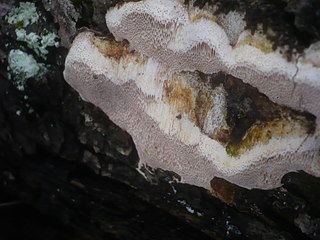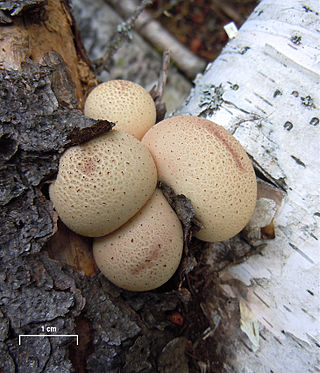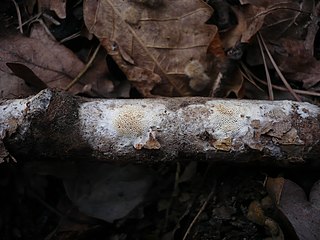
The Polyporales are an order of about 1800 species of fungi in the division Basidiomycota. The order includes some polypores as well as many corticioid fungi and a few agarics. Many species within the order are saprotrophic, most of them wood-rotters. Some genera, such as Ganoderma and Fomes, contain species that attack living tissues and then continue to degrade the wood of their dead hosts. Those of economic importance include several important pathogens of trees and a few species that cause damage by rotting structural timber. Some of the Polyporales are commercially cultivated and marketed for use as food items or in traditional Chinese medicine.

The Polyporaceae are a family of poroid fungi belonging to the Basidiomycota. The flesh of their fruit bodies varies from soft to very tough. Most members of this family have their hymenium in vertical pores on the underside of the caps, but some of them have gills or gill-like structures. Many species are brackets, but others have a definite stipe – for example, Polyporus badius.

Perenniporia subacida is a species of poroid fungus in the family Polyporaceae. It is a plant pathogen that infects Douglas firs. The fungus was originally described in 1885 by American mycologist Charles Horton Peck. Marinus Anton Donk transferred it to the genus Perenniporia in 1967. The four varieties of this fungus originally proposed by Peck, namely Polyporus subacidus var. stalactiticus, P. subacidus var. tenuis, P. subacidus var. tuberculosus and P. subacidus var. vesiculosus, have been shown to be synonyms. The species is inedible.

Perenniporia is a cosmopolitan genus of bracket-forming or crust-like polypores in the family Polyporaceae. They are dimitic or trimitic with smooth, thick-walled basidiospores and cause a white rot in affected wood.

Apioperdon pyriforme commonly known as the pear-shaped puffball or stump puffball, is a saprobic fungus present throughout much of the world. Emerging in autumn, this puffball is common and abundant on decaying logs of both deciduous and coniferous wood. It is considered a choice edible when still immature and the inner flesh is white. It is often called Lycoperdon pyriforme, but was transferred to Apioperdon in 2017 based on phylogenetic and morphological differences. It is the only species in the genus.

Ceriporiopsis is a genus of fungi in the family Phanerochaetaceae. The genus is widely distributed, and, according to a 2008 estimate, contains about 25 species. Ceriporiopsis was circumscribed in 1963 by Polish mycologist Stanislaw Domanski. The genus is a wastebasket taxon, containing "species that share common macroscopic and microscopic characteristics, but are not necessarily related." Ceriporiopsis species are crust fungi that cause a white rot. They have a monomitic hyphal system, containing only generative hyphae, and these hyphae have clamp connections.

Skeletocutis is a genus of about 40 species of poroid fungi in the family Polyporaceae. The genus has a cosmopolitan distribution, although most species are found in the Northern Hemisphere. It causes a white rot in a diverse array of woody substrates, and the fruit bodies grow as a crust on the surface of the decaying wood. Sometimes the edges of the crust are turned outward to form rudimentary bracket-like caps.

Tyromyces is a genus of poroid fungi in the family Polyporaceae. It was circumscribed by mycologist Petter Karsten in 1881. The type species is the widely distributed Tyromyces chioneus, commonly known as the white cheese polypore. The phylogenetic position of Tyromyces within the Polyporales is uncertain, but it appears that it does not belong to the "core polyporoid clade". Tyromyces is polyphyletic as it is currently circumscribed, and has been described as "a dumping place for monomitic white-rot species with thin-walled spores."

Morchella rufobrunnea, commonly known as the blushing morel, is a species of ascomycete fungus in the family Morchellaceae. A choice edible species, the fungus was described as new to science in 1998 by mycologists Gastón Guzmán and Fidel Tapia from collections made in Veracruz, Mexico. Its distribution was later revealed to be far more widespread after several DNA studies suggested that it is also present in the West Coast of the United States, Israel, Australia, Cyprus, Malta and Switzerland.
Perenniporia nanlingensis is a poroid fungus first isolated from Guangdong Province, China. It has crust-like fruit bodies with a pinkish pore surface when in dry condition. Microscopically, it has a trimitic hyphal system, a slightly dextrinoid and binding hyphae. Its basidiospores are ellipsoid, truncate, and measure 9.0–9.8 by 5.0–5.9 μm.
Skeletocutis yunnanensis is a species of poroid crust fungus in the family Polyporaceae that was described as a new species in 2016. The type specimen was collected in northern Yunnan Province, southwestern China, where it was found growing on decaying angiosperm wood in a temperate forest.
Rickiopora is a fungal genus of unknown familial placement in the order Polyporales. The genus is monotypic, containing the single neotropical species Rickiopora latemarginata.
Fragiliporia is the sole genus in the fungus family Fragiliporiaceae. It contains the poroid crust fungus Fragiliporia fragilis, described as new to science by Chinese mycologists in 2014. The type specimen of this fungus was discovered growing on a rotting stump of alder in the Gaoligongshan National Nature Reserve in Yunnan. The specific epithet fragilis refers to the brittle fruit bodies of the fungus. Molecular phylogenetics shows that the fungus is in an isolated position in the Polyporales, distinct from the six previously identified clades in this order. In a later study (2017), Fragiliporia was recovered in a phylogenetically isolated position as sister to Candelabrochaete africana.
Leifiporia is a genus of two species of poroid white rot crust fungi in the family Polyporaceae. The genus was circumscribed by Chinese mycologists in 2016 to accommodate the type species Leifiporia rhizomorpha.
Abundisporus mollissimus is a species of bracket fungus in the family Polyporaceae. This white rot fungus was described as new to science in 2015 by mycologists Bao-Kai Cui and Chang-Lin Zhao. The type was found fruiting on a fallen angiosperm trunk in Chengmai County ; it has also been found on a dead tree of Xanthophyllum hainanense. A. mollissimus is distinguished from other Abundisporus species by its effused-reflexed to pileate and soft fruit bodies, narrower skeletal hyphae, and spores that measure 4–4.5 by 3–3.5 μm.
Truncospora macrospora is a species of poroid fungus in the family Polyporaceae. It was described as new to science in 2013 by Chinese mycologists Bao-Kai Cui and Chang-Lin Zhao. The fungus, found in southwest China, is distinguished by its annual growth habit, and the distinct dark brownish crust on its caps. The semicircular caps measure about 1.5–3 cm (0.6–1.2 in) long, 2.5–3.5 cm (1.0–1.4 in) wide, and 1–4 cm (0.4–1.6 in) thick. Microscopic characteristics include its relatively large spores, measuring 16.5–19.5 by 8.0–9.5 μm, which have a strongly dextrinoid reaction. The type was collected in the Gaoligong Mountains at an altitude of 2,400 metres (7,900 ft), where it was found growing on a fallen angiosperm branch.
Skeletocutis friata is a rare species of poroid crust fungus in the family Polyporaceae. Found in Finland, it was first described as a new species in 1998 by Tuomo Niemelä and Reima Saarenoksa, with the name Skeletocutis friabilis. It was given the epithet friata three years later, after it was discovered that a tropical Asian species had already been given the name Skeletocutis friabilis, with a publication date two months prior to theirs. The holotype was collected by Saarenoksa in Sipoo, southern Finland, where it was found growing on the bark and exposed wood of a fallen twig of common alder. The authors later noted that subsequent searching of the type locality, as well as other locations in southern Finland, failed to turn up additional examples of this species.
Perenniporia puerensis is a poroid crust fungus in the family Polyporaceae. Found in Yunnan, China, it was described as a new species in 2017. The crust-like fruit body of the fungus have a yellow to ochraceous pore surface, with 4 to 6 pores per millimetre. P. puerensis has a dimitic hyphal system with non-dextrinoid and cyanophilous skeletal hyphae that are encrusted with pale-yellow crystals. The spores are egg-shaped to somewhat spherical, thick-walled, non-dextrinoid, and cyanophilous, with dimensions of 4.3–5.5 by 3.7–4.7 µm.
Radulotubus is a monotypic genus of corticioid or crust fungi in the family Radulomycetaceae containing the single resupinate species Radulotubus resupinatus. This species was found in Yunnan province, China and formally classified in 2016. The specimen was found growing on the fallen trunk of an angiosperm. It was originally placed in the family Pterulaceae and noted to be closesly related with Aphanobasidium and Radulomyces.
Physisporinus yunnanensis is a species of fungus belonging to the basidiomycetes, in the family Meripilaceae. It was described in early 2023 by Jia Cai. The species was found in Yunnan, China. It is a white rot fungus which forms bone-hard fruiting bodies which bear the basidia.








